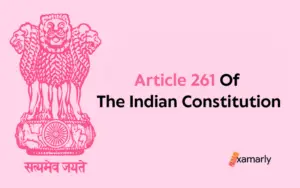Article 170 of the Indian Constitution talks about the composition of the State Legislature. It talks about all the parameters that are to be taken into consideration while the formation of the State Legislature.
It reflects on the major aspects like the number of seats in the Assembly and how it will be calculated, how is population related to the number of seats, among other important things.
We will dig deep into Article 170 of the Indian Constitution and understand all the clauses present in it in detail.
Article 170 Of The Indian Constitution – In Detail
We will understand each and every clause present in the Article in detail to have a good grasp on the concepts presented by Article 170 of the Indian Constitution.
Related Articles
Clause 1 – As it is & Explained
170. Composition of the Legislative Assemblies
(1) Subject to the provisions of Article 333, the Legislative Assembly of each State shall consist of not more than five hundred, and not less than sixty, members chosen by direct election from territorial constituencies in the State
The first clause of Article 170 of the Indian Constitution says that considering all the provisions of Article 333, the Legislative Assembly of each State will consist of not more than five hundred, and not less than sixty, members.
These members have to be chosen by direct election from territorial constituencies in the State.
The number of members in the Legislative Assembly of each State shall be determined by the number of territorial constituencies in the State.
Clause 2 – As it is & Explained
(2) For the purposes of clause ( 1 ), each State shall be divided into territorial constituencies in such manner that the ratio between the population of each constituency and the number of seats allotted to it shall, so far as practicable, be the same throughout the State Explanation In this clause, the expression population means the population as ascertained at the last preceding census of which the relevant figures have been published: Provided that the reference in this Explanation to the last preceding census of which the relevant figures have been published shall, until the relevant figures for the first census taken after the year 2000 have been published, be construed as a reference to the 1971 census
The second clause of Article 170 of the Indian Constitution says that in order to fulfil the purposes of Clause (1), each state shall be divided into territorial constituencies in such a way that the ratio between the population of each constituency and the number of seats allotted to it shall, as far as is practically possible, be the same throughout the state.
The explanation to this clause says that this is done to ensure that the population of each constituency is proportional to the number of seats allotted to it.
When used in this context, the term “population” refers to the total number of people counted at the most recent census for which all of the necessary statistics have been made public.
A reference in this Explanation to the most recent census for which the relevant figures have been made public shall, until the relevant figures for the first census taken after the year 2000 have been made public, be construed as a reference to the 1971 census. \
Provided, however, that this Explanation reference to the most recent census for which the relevant figures have been made public shall be construed as a reference to the 1971 census.
Clause 3 – As it is & Explained
(3) Upon the completion of each census, the total number of seats in the Legislative Assembly of each State and the division of each State into territorial constituencies shall be readjusted by such authority and in such manner as Parliament may by law determine: Provided that such readjustment shall not affect representation in the Legislative Assembly until the dissolution of the then existing Assembly: Provided further that such readjustment shall take effect from such date as the President may, by order, specify and until such readjustment takes effect, any election to the Legislative Assembly may be held on the basis of the territorial constituencies existing before such readjustment: Provided also that until the relevant figures for the first census taken after the year 2000 have been published, it shall not be necessary to readjust the total number of seats in the Legislative Assembly of each State and the division of such State into territorial constituencies under this clause
The third clause of Article 170 of the Indian Constitution says that following the conclusion of each census, the total number of seats in the Legislative Assembly of each State and the partition of each State into territorial constituencies are subject to a readjustment by such authority and in such way as Parliament determines lawfully from time to time:
It also says that however, that such readjustment shall not have any effect on representation in the Legislative Assembly until the dissolution of the Assembly as it existed at the time
Provided further that such readjustment shall take effect from such date as the President may, by order, specify and provided further that until such readjustment takes effect, any election to the Legislative Assembly may be held on the basis of the territorial constituencies that existed before such readjustment.
Also that until the relevant figures for the first census taken after the year 2000 have been published, it shall not be necessary to readjust the total number of seats in the Legislative Assembly of each State and the division of such State into territorial constituencies in accordance with the provisions of this clause.
This is because the relevant figures for the first census taken after the year 2000 will not be published until after the year 2000.
Summing Up
We can conclude from this Article that the population of a state is directly proportional to the number of seats in the Assembly.
We can see here that so many important factors are considered while deciding the number of seats in the assembly. Despite, a defined upper limit and a lower limit for the number of seats, it varies from state to state as the population varies from state to state.
FAQs
What is the upper limit and the lower limit of the members in the Legislative Assembly?
As per Article 170 of the Indian Constitution, each state shall have members of not more than 500 and not less than 60 in their legislative assembly.
How are the members of the legislative assembly selected?
The members of the legislative assembly are chosen by direct elections from the territorial constituencies of India.
What does the second clause of Article 170 of the Indian Constitution say?
The second clause of Article 170 of the Indian Constitution says that in order to fulfil the purposes of Clause (1), each state shall be divided into territorial constituencies in such a way that the ratio between the population of each constituency and the number of seats allotted to it shall, as far as is practically possible, be the same throughout the state.
Which article is related to Vidhan Parishad?
Article 169 of the Constitution of India outlines its origin and purpose for being in existence. Six of the 28 states (as of the year 2022) are governed by a State Legislative Council. These include Andhra Pradesh, Karnataka, Telangana, Maharashtra, Bihar, and Uttar Pradesh.






